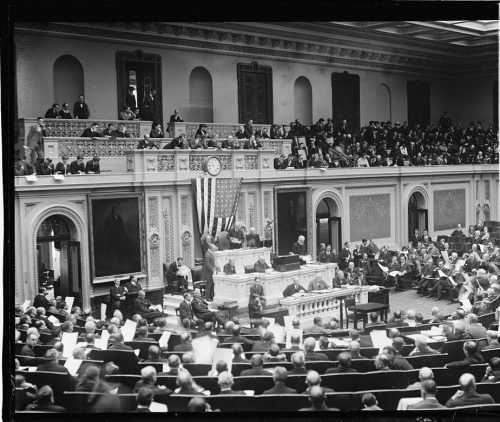
Electing the US President: What Happens Between Election Day and the Final Announcement of the Results?
Many predicted a complicated national election in 2020, in large part due to the circumstances of the pandemic. An unprecedented number of voters cast absentee votes—according to the Washington Post, at least 101.9 million, more than double the number of such ballots in 2016. Due to an urgent sense of the election’s significance, voter turnout was also high—the highest in more than a century, at about 67% as of early on November 4. These factors are prolonging the tallying of votes cast.
It is, of course, not the popular vote that determines the choice of president; rather, balloting in the Electoral College determines the outcome. So, let’s review what happens when the voting ends.
Each state is granted a number of electors equal to the combined number of its Senators and Congressmen. As stipulated by Article II, section 1, each state legislature sets its own rules for selecting these electors. In most states, each party selects a slate of electors to represent its candidate, and the outcome of the vote triggers selection of one slate or the other. Although the Constitution does not require that all the electors allotted to a given state vote for the same candidate, most states follow the “winner take all” rule. In the states that do not—Maine and Nebraska—two electors represent the statewide winner, while the others represent the winners of congressional districts.
The total number of electors is 538; the winning presidential candidate must receive at least 270 of those votes. In many election years, the popular vote cast on Election Day swings decisively to one of the candidates, clarifying the outcome before the night is over, while the counting of absentee ballots is still ongoing. The absentee votes are counted nevertheless, since an accurate count of all votes is required by law. But most voters consider the election over and decided. What happens when the vote is tight and the outcome is unclear for several days? If close outcomes bring challenges by the losing party, how are these challenges resolved? At what point is the election decided and final? The Constitution outlines a process; federal law clarifies its schedule.
Calendar of Events During the Presidential Election
- Each state legislature specifies how the popular vote is counted and verified; states control that process, through laws enacted, in most cases, decades ago. Nevertheless, party representatives from inside and outside the state are normally present to observe the counting of votes.
- In accordance with federal law, the governors (or in some cases, a state’s secretary of state) must report the presidential election results of their states “as soon as is practicable” to the US Archivist. The governor (or other state executive) transmits a “Certificate of Ascertainment” to the Archivist, carrying the seal of the state and listing the winning candidates for president and vice president, the electors chosen to represent those candidates in the electoral college, and the number of votes this slate of electors received. The governor also submits Certificates of Ascertainment to the electors who have been chosen.
- When a closely divided count of votes is challenged by the losing party, state law governs how the dispute is settled. Federal law intervenes only by setting a calendar limit to such challenges. It specifies a “safe harbor” date by which election results from each state must be reported to the US Archivist. This date is six days prior to the date on which the chosen electors of each state meet to cast their formal ballots. In 2020, the safe harbor date is December 8. In the event of contested results within a state, the governor must send to the U.S. Archivist not only the Certificate of Ascertainment but also a certificate explaining the legal process by which the final determination of the vote count was made.
- The Electoral College—all 538 members—never meet in one body; rather, the chosen electors for each state meet in some location designated by state law to formally cast their ballots. This happens on the Monday following the second Wednesday of December—December 14 in 2020. Each state’s college of electors records the vote on “Certificates of the Vote” which the electors pair with the Certificates of Ascertainment sent them by the Governor. They sign, seal, and certify these certificates and transmit them by registered mail to several parties: the U.S. Archivist, the President of the U.S. Senate (the current Vice President), the Secretary of State of their own state, and the judge of the U.S. District Court where they met. These certificates must be transmitted by the fourth Wednesday in December—December 23 in 2020.
- On January 6, the Senate and the House of Representatives meet in joint Session to count the electoral votes transmitted to them by the states. At the conclusion of this count, as long as one of the candidates has received 270 or more of the Electoral College ballots cast, the sitting vice president announces the result and the election outcome is decided.
Possible Complications

Can any circumstance disrupt this calendar of events? From the perspective of the Constitution, a problem could occur on January 6—if two opposing candidates for president receive the same number of electoral votes. This has occurred twice in our history—in 1800 and 1824. In these cases, the deciding vote was taken in the House of Representatives, as the Constitution specifies. But the Constitution specifies a unique manner of voting in this circumstance: each state delegation is allowed to cast only one vote. That is, all the Congressmen for all the districts in a state must meet and hash out how their single vote will be cast. If the result today were a 25 to 25 split, balloting would have to continue until one of the delegations changed its vote. Something like that happened in 1800—but it was far more likely to occur then than now, because at the time, electors did not cast distinct votes for president and vice president (See our interview with Professor Jeremy Bailey, published on October 15).
Another situation occurred in 1876: the returns in three states were contested, so that the final count of electoral votes could not be determined. This happened because the governors of these states submitted one slate of electors while the legislatures submitted another. Congress decided to appoint a commission to determine the outcome of the election. Today, the law which today specifies a safe harbor date by which state executives must certify and report election results is supposed to prevent a recurrence of this problem. (In a different case—the contested 2000 presidential election—the Supreme Court pointed to the safe harbor deadline when ruling that recounting of votes in Florida had to stop.) Still, some scholars think that in states where party control of the governorship and legislature is split, legislatures might defy this law. Such a situation would likely result in appeals to the courts (For more, see our interview with Professor Bailey).
State laws governing recounts vary. Some states’ laws specify that disputes over the vote count must be settled by the state legislature; in other states, they must be settled in the courts. Confusion over these differences means that ascertaining the final vote counts—at least prior to the safe harbor date—will occur in an atmosphere of partisan contention. If this year’s election results are indeed contested in more than one state, the American people will need calm and objective voices willing to explain the reasons for differences between the states’ procedures.
The Protections Afforded By Our Electoral College System
The Electoral College system is unique to the United States, and many have asked whether this Constitutional provision unnecessarily complicates our process or, worse, defies the will of the majority. The system is one of several federal provisions of the Constitution that balance the power of each American’s vote against the power of each state’s decision. Yet it also serves another crucial function: it helps secure the integrity of our presidential elections. In the United States, our presidential elections must be certified by fifty different state governors, inevitably of different parties. In other countries, an appointive national election board controls the process. It would be easier to subvert one board than 50 different state systems.
Additionally, the variant procedures put in place by state legislatures to resolve disputed vote counts afford another security. Not every disputed state count will work its way through the court system, potentially reaching the Supreme Court. Indeed, the framers did not intend for the judicial branch to exert any influence on our presidential elections. They saw the national legislature as the appropriate place for a disputed election to be resolved.


